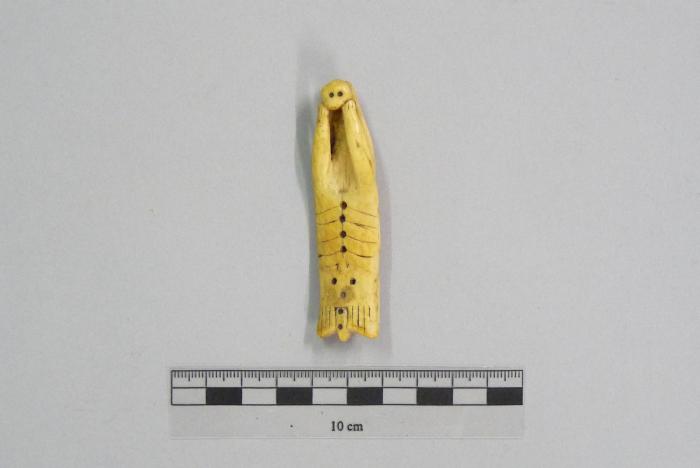Kayak ornament from whale bone
Angelina Roehl (Contributor)
Dawn Randazzo (Contributor)
Nadia Jackinsky (Contributor)
Jessica Towns (Contributor)
Heather Metrokin Cannon (Contributor)
Brandon Moonin (Contributor)
Kristin K'eit (Contributor)
Johnny Moonin (Contributor)
Dawn Randazzo (Contributor)
Nadia Jackinsky (Contributor)
Jessica Towns (Contributor)
Heather Metrokin Cannon (Contributor)
Brandon Moonin (Contributor)
Kristin K'eit (Contributor)
Johnny Moonin (Contributor)
Angelina Kalunka Roehl: (Sugt’stun word for Spine or skeleton are very close to Jacobsen's indigenous recorded word)
Dawn Randazzo: Andrew Abyo told me that they would traditionally paint the frame of the qayaq red and sometimes with blood, and the frame would symbolize the skeleton. Traditionally you were not supposed to eat sea otters. You were supposed to put their bones back in the water.
Nadia Jackinksy: In a book about Nanwalek. When there was a large Tsunami they turned themselves into sea otters to escape from the Tsunami. This is why they were respected and not eaten.
Jessica Town: Another story in her community speaks of a boy who dove down into the water and got stuck and joined a sea otter. This is a reason why otters are respected.
Heather Metrokin Cannon : From my family from Kodiak- sea otters are our brothers and sisters. We never eat them.
Brandon Moonin: my apaa told me that sea otters were part of our family and should be treated as such.
Brandon Moonin: perhaps, because it is considered an amulet. With possible ties to Shamanism it could be considered taboo to replicate
Brandon Moonin: This can be a good thing and does not need to be seen as a bad omen or negative.
Kristin K’eit: Shamanism is often seen as bad, but it does not need to mean this and was often made into a negative thing through Christian beliefs and assimilation.
Angelina Kalunka Roehl: Do the holes have symbolism that resemble the different body parts where the spirit enters or leaves?
Johnny Moonin: The holes on the back show that they were maybe sown into visors or clothing or used to sow onto something.
Dawn Randazzo: Andrew Abyo told me that they would traditionally paint the frame of the qayaq red and sometimes with blood, and the frame would symbolize the skeleton. Traditionally you were not supposed to eat sea otters. You were supposed to put their bones back in the water.
Nadia Jackinksy: In a book about Nanwalek. When there was a large Tsunami they turned themselves into sea otters to escape from the Tsunami. This is why they were respected and not eaten.
Jessica Town: Another story in her community speaks of a boy who dove down into the water and got stuck and joined a sea otter. This is a reason why otters are respected.
Heather Metrokin Cannon : From my family from Kodiak- sea otters are our brothers and sisters. We never eat them.
Brandon Moonin: my apaa told me that sea otters were part of our family and should be treated as such.
Brandon Moonin: perhaps, because it is considered an amulet. With possible ties to Shamanism it could be considered taboo to replicate
Brandon Moonin: This can be a good thing and does not need to be seen as a bad omen or negative.
Kristin K’eit: Shamanism is often seen as bad, but it does not need to mean this and was often made into a negative thing through Christian beliefs and assimilation.
Angelina Kalunka Roehl: Do the holes have symbolism that resemble the different body parts where the spirit enters or leaves?
Johnny Moonin: The holes on the back show that they were maybe sown into visors or clothing or used to sow onto something.
Do you have a story to contribute or a comment about this item?
Login/register to comment 